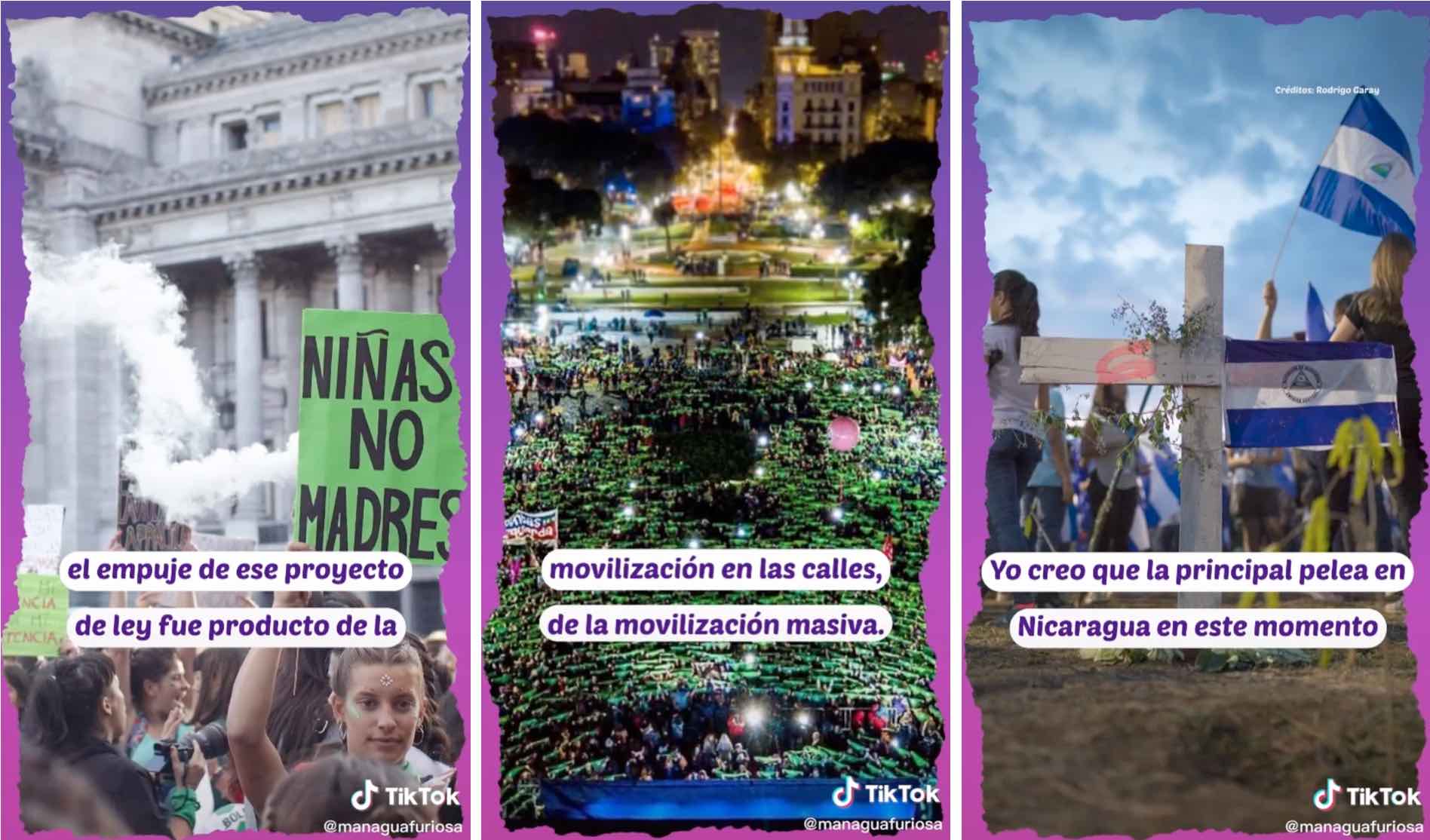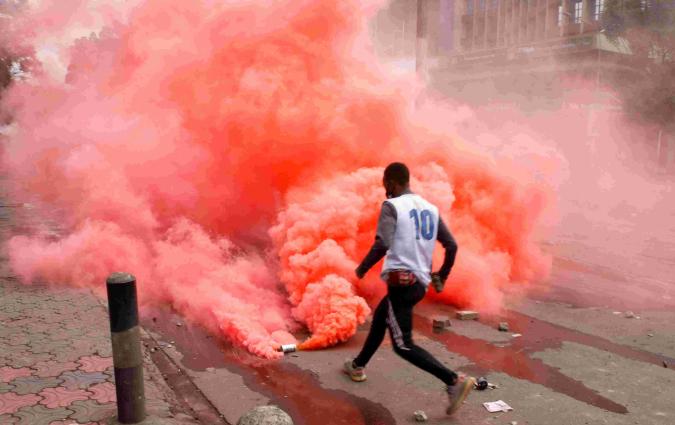From fact-checking to women’s rights: TikTok's promising rise in the Global South

TikTok posts from Nicaraguan news site 'Managua Furiosa'.
Beyond the COVID-19 pandemic, 2020 was TikTok’s year. The app reportedly added 181 million monthly active users from December 2019 to July 2020 taking its total to 689 million. The growth didn’t just happen in its native China: the proportion of global internet users aged 16-64 who used it grew from 11% in 2019 to 18% in 2020.
Although it’s not the primary social network for most audiences, TikTok’s popularity is growing in the Global South. Downloads in Southeast Asia reached 360 million in 2020, with 151% growth year-on-year. In Mexico, Brazil and Argentina downloads skyrocketed by July 2020 to 64.4 million. They were only 5 million a year before.
Journalists and newsrooms are looking to take advantage of this growth too. With its highly creative visuals and typically younger demographic, Tiktok offers newsrooms a chance to connect with the next generation of audiences and to pioneer new formats, while trying to understand how information (and misinformation) travels today. Outlets in Brazil and Nicaragua are just a year or less into their TikTok experiments, while AFP has expanded its fact-checking services to the platform in Asia-Pacific.
Translating TV news into TikTok
Jornal da Record, Brazil’s second largest daily national news programme, launched its TikTok account in February 2020. At the time of writing, it has attracted around 345,200 followers on the platform and its posts have been liked more than 3 million times. The team behind the account wanted to be pioneers on a platform where no other Brazilian media groups were present at the time, says Thiago Antunes Contreira, Head of Content for the Journalism Department at Jornal da Record’s broadcaster, RecordTV.
A small group of interns and young journalists has been involved with the account from the start. “They have the skills to talk directly with that audience but they discuss the content with the most experienced journalists [in the newsroom]. We try to find a balance. The young team are familiar with the app, but at the same time need to be guided,” he says.
The focus is on covering news in a way that fits the platform’s culture. “TikTok challenges,” for example, are used to cover COVID-19, healthcare and climate change. The newsroom has embraced the popularity of dance, music and choreographed routines on the app as well as a humorous tone. These formats allow them to show how the Jornal’s teams work behind-the-scenes, from how an editor builds a story to an intern’s first days.
“These videos show some curiosities about the journalist’s routine that the public doesn’t often see. It’s a way to show that our reporters and presenters are ‘regular’ people,” says Contreira.
@jornaldarecord Sobre a eficácia da Coronavac. ##foryou ##noticias ##jornalismo ##recordtv
♬ som original - Jornal da Record
Within the next year, the newsroom hopes to grow the account to 500,000 followers and beyond. Training is also required to encourage more journalists to contribute. For Jornal da Record, TikTok is both a chance to reach a “more diverse” audience and a powerful storytelling tool: “It’s a way for us to connect with a large, younger audience and potentially bring these people to watch our programme on television as well,” he says.
Fighting for women’s rights
For some publishers, TikTok is not just a space to reach new audiences but also a channel where challenging topics can be addressed in a different way. Independent digital outlet Managua Furiosa in Nicaragua covers art, culture and human rights in the country. Its work on TikTok and Instagram Reels is the latest step in shifting its content strategy to engage with a broader audience, with a particular focus on women and LGBTQI+ people.
When TikTok first started in Latin America, the platform’s content moderation policies for the region weren’t as developed, says Managua Furiosa’s Malva Izquierdo, who is now a Journalist Fellow at the Reuters Institute. This period of fewer restrictions allowed many videos sharing misinformation about women’s rights to be posted. As a result, the response from TikTok now to any content posted on the topic, however accurate, is much stronger, Izquierdo believes: “This time of ‘let’s post whatever we want because there’s no policy in place’ has made it harder now when we want to share something serious about these topics.”
While its TikTok account is still small in terms of followers and Internet penetration in Nicaragua was only around 28% in 2018, the right topics covered in the right way can still go viral and find a big audience. Managua Furiosa’s TikTok video looking at obstetric violence against women was a viral success with around 84,000 views to date. The timing of the post was crucial: abortion had just been legalised in Argentina and the decision was major news in Nicaragua, where it’s still illegal. Managua Furiosa was able to tap into a TikTok audience interested in a wider Latin America experience and in women’s rights, says Izquierdo. The outlet believes TikTok provides an opportunity to reach audiences who are interested in shaping legislation in Nicaragua and beyond.
@managuafuriosa Basta de #violenciaobstetrica, demandamos #derechosfundamentales para todas las #mujeres. #femism #feminismo
♬ sonido original - Managua Furiosa
At the time of writing, Managua Furiosa’s account only has seven live posts. But this doesn’t give the full picture of the account, which was launched in August 2020. TikTok has removed several of its videos. Clips relating to abortion, including discussion of legalising abortion in Nicaragua or access to abortion for women who have been raped, have been removed by TikTok, says Izquierdo: “Unless we do it very subtly, it will be removed. We’ve found the audience for these topics, but it’s a struggle to actually reach them because TikTok takes the posts down.”
To deal with these restrictions, the team will re-edit clips, removing anything that could be seen to incite violence or discomfort and re-upload them hoping for a different outcome: “We have to find ways to still put the content out there and keep it live as much as possible,” she says.
In July last year, a TikTokker from Nicaragua was detained and interrogated by federal agents for posts that allegedly criticised the government. Exploring these new platforms is dangerous for Nicaraguan journalists too. Press freedom groups have raised concerns that recent draft legislation by Daniel Ortega’s authoritarian government will criminalise journalists working online.
“We know TikTok is an online platform and [the government] could block it – that’s the best case scenario. We could be harassed, threatened or imprisoned,” says Izquierdo, adding that her team has taken security measures to keep everybody safe. They have posted on TikTok about the proposed legislation, but are wary of posting more videos challenging the current government in case it leads to restrictions. It’s an election year and it’s more important for Managua Furiosa to keep its accounts up and running so they can continue to draw attention to social issues.
From geopolitics to fact-checking
Politics has also been a factor in other countries. TikTok was briefly banned twice in India, reportedly the app’s largest market beyond China, with as many as 200 million monthly active users. The ban was made permanent in January this year. following an altercation with China at a disputed Himalayan border which killed 20 Indian soldiers. Pakistan followed suit and banned TikTok over “immoral and objectionable videos” in March 2021.
For newsrooms investing effort in the platform, geopolitical issues are a cause for concern. Uncertain of how discussions between the US and TikTok would resolve, the team at Jornal da Record could only hope its TikTok work isn’t going to “end nowhere”.
“While geopolitical issues might still be a challenge [for TikTok], there is a focus towards getting content moderation policies on track,” says Dymples Leong, a senior analyst with the Centre of Excellence for National Security (CENS) at the S. Rajaratnam School of International Studies in Singapore. TikTok has been criticised before for not doing enough to curb COVID-19 misinformation, but has “sharpened response rates'' and has forged partnerships with fact-checking initiatives, including the Agence France-Presse’s AFP Fact Check service.
Content moderation guidelines have been localised for individual South-East Asian countries by appointing local content moderators, explains Leong, and TikTok has appointed a Safety Advisory Council for the Asia Pacific region: “[TikTok] wants to highlight that safety on its platform is a key priority for them.”
In October 2020, AFP expanded its fact-checking operations in the Philippines, Indonesia, Pakistan, Myanmar, Australia and New Zealand in a partnership with TikTok. The Fact Check Asia team assesses potentially false or misleading videos shared on the platform in these regions before sending reports to TikTok as part of a commercial relationship.
“The uptake in the popularity of these platforms sometimes outpaces their ability to understand how people in these markets are using them. [At TikTok] they are really aware of that,” says Cat Barton, Head of AFP Fact Check, Asia, who has around 20 specialist reporters working on digital investigations covering most of Asia Pacific, including India, Pakistan and Myanmar. New recruits have recently joined to cover the expansion to fact-checking on TikTok as well as recent launches of fact-checking across the region, including South Korea and Myanmar.
In recruitment interviews, applicants frequently cite relatives sharing misinformation as an important reason for wanting to work as a fact-checker, says Barton: “I think it speaks to the difficulties of digital literacy particularly for these older generations and young reporters desperate to provide accurate reporting to stop their grandparents falling for these hoaxes.”
The crash of a passenger plane in Indonesia on 9 January 2021 was the first major news event where it checked TikTok. TikTok uses AFP’s work in a different way to Facebook, but the standards are the same, with a heavy emphasis on video verification.
Debunking vaccine falsehoods
TikTok provides another platform on which “old”, even previously debunked material, can resurface. This is a reflection of how audiences, especially in South-East Asia, use multiple apps and platforms at a given time, cross-pollinating and posting content between them, says Leong.
While any misinformation might not be new, the format may be adapted to suit Tiktok and take advantage of its distribution network. The AFP team has seen evidence of snippets from longer videos originating on YouTube and resurfacing on TikTok. For example, footage of clairvoyants in Indonesia making predictions or talking with victims of disasters.
“Sometimes it can be disheartening when we're debunking a video from India of a crocodile in a sewer that appears in every single town after flooding,” says Barton. “But if we can make people on TikTok understand that the people [in this video] did not have a seizure after getting a COVID-19 vaccine and that convinces a few people that it's worth going to get vaccinated, it's a very important service to be doing.”
The team has seen the spread of misinformation on TikTok and other social platforms track the development of the pandemic in different countries. Leong sees the same pattern on TikTok in South and South-East Asia. In the first half of 2020, misinformation shared revolved around supposed ‘miracle cures’ for coronavirus. In 2021, as COVID-19 vaccines have been approved and are being rolled out in Asia, misinformation has shifted focus to false information concerning vaccinations.
“Takedowns of false information on one platform could lead to others migrating to another platform,” she says, referencing snippets from the disinformation-laden ‘Plandemic’ video that found their way onto TikTok in May 2020 even after the video had been removed by YouTube and Facebook. While TikTok did take action, “there is this further reinforcement of false narratives across platforms,” says Leong.
TikTok has added a coronavirus information section to users’ Discover page where they can search for related topics and similar links from posts that contain words, hashtags or music relating to COVID-19.
The company has also said only a “low-level” of videos globally have had to be removed owing to coronavirus-related misinformation. Its transparency report for the second half of 2020 says 51,505 videos were removed during this period for “promoting COVID-19 misinformation”, 86% of which were removed before they were reported to TikTok and 87% within the first 24 hours. The top five markets in terms of the volume of content removed were Pakistan, Brazil and Indonesia, with more than 16.5 million videos removed between them.
Speed matters, though. In January, the AFP Fact Check team in Asia established that pictures circulating on Facebook and TikTok showing burned ballot papers as evidence of voter fraud in Myanmar’s 2020 elections were, in fact, images of old ballots from the 2015 elections.
“It's really important to act quickly. The work we do shows it's not just in America where that matters. It matters in Myanmar. It matters in India, including at a state level,” says Barton, adding that her team is already seeing misinformation emerging ahead of elections in West Bengal scheduled for April and May. “It's really important that this kind of stuff isn't allowed to circulate just because it's not as high profile in the Western media as the US elections are.”
Voice and resources matter
As with any new product or social account, resourcing is a major challenge to its success. Jornal da Record doesn’t have a team exclusively for running TikTok, and this makes frequency and consistency of posting an issue. It’s difficult to create more than two posts per week without expanding the social media team, says Contreira. Without a community manager, engaging in comments on TikTok is also not possible.
Finding the right voice for a news brand on a platform known for its humour is another early hurdle. How can you match TikTok’s playfulness when talking about subjects as serious as science and health? It’s about drawing a tonal line, says Contreira: “Tiktok can be a trap if you try to imitate all the viral trends. We can use comedy but our goal is to present a message that fits with Record TV content. We want to promote information, not dance.”
Facebook’s “TikTok killer” Reels was first launched in Brazil and the company will no doubt invest heavily in operations and features aimed at Global South markets where TikTok has shown growth. For journalists and newsrooms in these areas, it’s another platform to manage but also another opportunity to hone the skills and storytelling techniques that can work best for short-format video and younger audiences.
Few outlets in the Global South are present either on TikTok or Reels right now and creeping legislation and state shutdowns may keep it that way. But for those willing to experiment, however briefly, it’s an opportunity to engage new audiences, counter misinformation and learn new narrative languages.
Laura Oliver is a freelance journalist based in the UK. She has written for the 'Guardian', BBC, 'The Week' and more. She is a visiting lecturer in online journalism at City, University of London, and works as an audience strategy consultant for newsrooms. You can find her work here.







